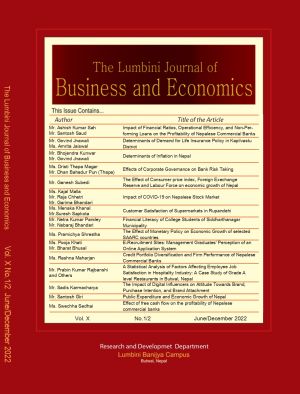Determinants of Inflation in Nepal
DOI:
https://doi.org/10.3126/ljbe.v10i1-2.53893Keywords:
Inflation, Money Supply, Determinant, Nepal, Government ExpenditureAbstract
In the context of Nepal, this study investigates the long- and short-term factors that affect inflation with monthly time series data of fiscal year 2016/17 to 2021/22 (72 observations) employing the ARDL bounds test and error correction technique of econometric analysis. In order to identify the order of integration, the stationary of all variables were investigated by running PP test. Variables are found to be stationary at the level I (0) and first I(1) difference. In this study, Consumer Price Index (CPI) is the dependent variable, and Interest Rate (IR), Broad Money Supply (M2), Government Expenditure (GE), and Consumer Price Index of India (CPII) are the independent variables. The study shows that government expenditure is the most significant determinant of inflation in the long run, followed by interest rates. This study has also shown that inflation is negatively related to broad money supply and government expenditure with high significant. In contrast, the interest rate and CPI of India are positively significant with inflation in the short run. These results suggest that controlling government expenditure and interest rate are key to the success of the disinflation effort in Nepal and could be used as an intermediate target variable in the fiscal policy and monetary policy by the government of Nepal and the Nepal Rastra Bank Respectively.




